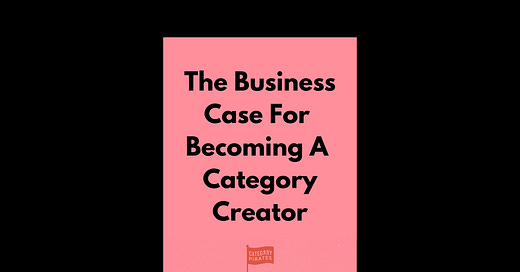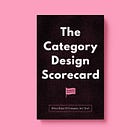The Business Case For Becoming A Category Creator (And Why Most People Ignore It)
Take Xerox, for example.
Dear Friend, Subscriber, and fellow Category Pirate,
Category designers introduce the world to new ways of living, working and playing.
They are people and companies who move the world from the way it is, to the way they think it should be—often by solving a problem people didn’t know they had, or by reimagining a known problem and then creating the potential for a radically different solution. Most of all, they create (and subsequently capture) the exponential new value generated by an ecosystem of employees, customers, partners, investors, and communities.
TL;DR: category designers play the game differently, and experience outsized rewards as a result.
To make sure our Kool-Aid tasted as good as we thought it did, we recently conducted a set of studies to wrap our brains around the difference between Category Creators and other fast-growing, successful businesses.
We analyzed the Fortune 100 fast-growing companies list from 2009 to 2018.
Using our Category Design Scorecard, we found only 19 percent of the fast-growing companies were actually category creators. But stunningly, the category creators captured the vast majority of the growth: 51 percent of the prior three years cumulative revenue growth, and 80 percent of the prior three years market capitalization.
That’s not just differentiation.
That’s radical differentiation.
Companies that create new categories or successfully redesign existing categories are the ones that ultimately change the world AND create exponentially more value for both shareholders and the entire market in the process.
Now, if there’s data that supports our thesis that category design is the fastest, most effective way to grow, then why do so many companies insist on competing?
Fortune 500 companies have the hardest time understanding category design as a growth strategy.
They are conservative for a reason. They have “stuff” to conserve.
That “stuff” is everything from existing market share to quarterly company profits to investor relationships to balance sheet optics. In most large companies (and in many existing smaller companies as well), executives get paid to “Not f*ck things up.”
These incumbent companies are often themselves aging Category Kings. They were once the rebel-headed upstart pioneering new territory in the business landscape, but now, they are stuck defending the slow-moving, slow-growing category with which they’ve become synonymous. So much so, that despite incrementally growing profits year over year, many feel no urgency to change.
The unfortunate reality is that the fear of losing what ground they have today is greater than the exponential value that could be generated by embracing category innovation tomorrow. These companies live out their days bound (like hostages) to the tyranny of quarterly expectations, trying to convince themselves, their employees, and their shareholders there is still “a bit more juice left in the squeeze.”
Winning isn’t a destination—it’s a constant state of category design.
If history has taught us anything, it’s that successful companies of the past are rarely the ones that stay alive long enough to create the future.
There was a point in time when Xerox was one of the most innovative companies on the planet. In 1959, the Xerox 914 copier was seen as a breakthrough product because it didn’t require special paper and could print multiple copies per minute. Fortune called it, “The most successful product ever marketed in America.”
For decades, Xerox changed the business landscape—with Xerox machines in nearly every major office on the planet. And today, Xerox still does nearly $6 billion in annual revenue (2020).
Unfortunately, that’s a fraction of the $20 billion in revenue it was doing from 2011 to 2014.
Ask anyone in 2021 what they think of Xerox and they’ll probably say:
“Is Xerox still alive?”
“Oh man, I can’t remember the last time I used a copy machine.”
“The world is going paperless. Xerox is going to die.”
And so on.
Nobody cares about Xerox anymore because Xerox—again, 40 years ago, one of the most legendary companies of all time—no longer dominates any category that matters.
It’s not that Xerox, the brand, has lost its flair. Xerox has a great brand.
It’s that the CATEGORY, wherein Xerox is / was Category King, no longer matters. It’s declining. It’s contracting. It’s drying up, like a raisin in the sun.
As digital storage products and paperless culture have grabbed hold, Xerox’s category has been redesigned—not by Xerox, but by new companies with a different vision of the future. As a result, the company is now securely fastened into a tailspin with revenues declining 35% year-over-year.
They don’t have a branding problem.
They have a category problem.
As a result, executives, shareholders, and employees are stuck in a game of defending what they once had (chasing market share) opposed to creating what could be. They know their time is limited, and so they are trying to squeeze as much “juice out of the lemon” before the company, and its entire category, goes to zero.
Which leads us to the morale of our story:
Legendary companies, and people with legendary careers, create new things. They don’t fight over old things.
To be blunt, if you don’t start, invest in, or work for a category creator or category-designing company, you are settling for a loser’s life. Consciously or unconsciously, you are saying, “I don’t want to be part of creating the future.”
(We are being brash and blunt to emphasize a sense of urgency.)
Now to be fair, most successful businesses are partially about monetizing the past and partially about inventing the future. The problem is getting the past-milking and future-creating mix right. Because the truth is:
The past feels comfortable.
The past creates an illusion of comfort.
The past has gravitational pull.
As a result, business people want to be part of capitalizing on the past, and getting in while the getting is good.
This gravity is what sucks down Fortune 500 companies and startups. In the short term, attaching to an existing market category can seem advantageous. The rewards appear more likely guaranteed. And like most “conventional wisdom,” chasing the gravitational pull of the past tricks even the most seasoned executives, entrepreneurs, and venture capitalists into making the mistake of trying to build better, faster, cheaper, smarter versions of already proven products.
But let us tell you a quick story to accentuate our point:
Andy Rubin, creator of smartphone software Android, made this mistake.
And as a result, his company “Essential Products” went from being worth $1 billion in 2017 to bankrupt in 2020.
Maybe he prays at the “best product wins” alter too?
On the other hand, the original Android phone was different. And when Google purchased Android and gave it away, it became super different. But when Rubin left to start his new smartphone company Essential, he embraced a “Better Product” vs. Different Category strategy.
That category blunder cost his investors $330 million.
Category failures waste investors money, for sure. But the loss comes in two forms. Money lost and value wasted in unrealized category potential. If Rubin had designed a different product, company, and category, he might have created massive new value. All of that potential is lost now too.
It is our core belief that deep within each and every human being is an innate desire to create.
It just so happens the joy of creating often comes with outsized rewards.
In the beginning, and certainly along the way, category creators building a “different” future rarely seem like the safest bet when assessing surface-level metrics (such as: “the fastest growing companies of the year”).
But our research reveals that when assessing a company on five key areas related to their advancing foothold in a new or existing category, there are unquestionable signals as to whether or not that company will become “king/queen”—and capture two-thirds of that category’s economics as a result.
What are those five key areas, you ask?
You can find out here:
Arrrrrr,
Category Pirates
P.S. - If reading this taught you something new and different…
Click the ❤️ button on this post so more people can discover it on Substack. 🙏 🏴☠️
And if you’d like to go down the Category Design rabbit hole even further, we encourage you to dig into our books:







I remember hearing my mom say she needed to "Xerox" things to make copies of them back when I was a kid. While it's sad that companies likes Xerox that relied on old technology fall away, it's a valuable lesson to keep a day one mentality and innovate as much as possible to stay relevant in these rapidly changing times.
Do you have any more details supporting evidence from analyzing the Fortune 100 list?